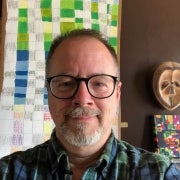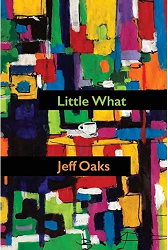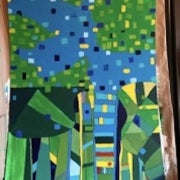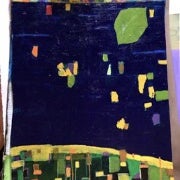 Jeff Oaks is a poet. He is a writer. He is a professor. He is many great things. Most recently, he has become an artist. When global events take a toll on how you go about daily life, we all have our own ways of finding outlets and ways to be happy in this complicated world in which we live. For Jeff Oaks, it is painting.
Jeff Oaks is a poet. He is a writer. He is a professor. He is many great things. Most recently, he has become an artist. When global events take a toll on how you go about daily life, we all have our own ways of finding outlets and ways to be happy in this complicated world in which we live. For Jeff Oaks, it is painting.
At the University of Pittsburgh, Jeff Oaks completed an MFA in poetry in 1990 and began teaching writing courses, including creative writing and poetry. After a series of great student evaluations and many quality years at Pitt, Oaks landed a job as a lecturer. He served as the managing director of the Pittsburgh Contemporary Writers’ Series for 11 years while still teaching creative writing. In 2011 or 2012, he became assistant director for the Writing program, and in 2019, the department created a director of undergraduate studies position. Unstoppable, Jeff Oaks applied and got the position for the Writing program. He still holds this job, now as a senior lecturer, while also teaching two classes per semester. In 2019, Lily Poetry published his first poetry book: Little What.
Oaks has been a writer his whole life, especially since his arrival at Pitt in 1987 as a graduate student. When he was young, he met a professional writer who was workshopping at a local school. “She was one of the first adults I ever saw be happy,” he said. Not wanting to grow up and be miserable like the adults around him, he soon found his voice in writing. “It went against everything that my family wanted or expected from me,” he recalled.
All the while, being a visual artist stayed at the back of his mind. Oaks grew up surrounded by art; his brother was an artist, and Jeff’s mind was cluttered with ceramics, canvases, and paint. He took drawing classes throughout high school and college and loved it—but he knew it costs a lot more money to be an artist than it does to be a writer. After all, the only things that you need to be a writer are a pen, some paper, and maybe a typewriter (or a computer, as we moved into the digital age). Being an artist wasn’t as simple. It meant the big fuss of obtaining expensive paper, materials, and studio space as well as constantly keeping up with having fresh paints and clean brushes.
So Jeff Oaks became a writer.
And he stayed committed to being a writer. In the late aughts, he submitted to an anthology, My Diva: 65 Gay Men on the Women Who Inspire Them (University of Wisconsin Press, 2009). He had written an outstanding essay on Wonder Woman instead of a poem, his usual genre. This was the moment where he first realized he could do something other than poetry.
This moment liberated Oaks in a way, he said. He wrote more essays and continued to be happy doing that while simultaneously improving his poetry.

But then, the presidential election occurred in 2016. When former President Trump was elected, Oaks felt “part grief, part anger, part frustration with my fellow Americans, part terror.” He also felt a strong sense of despair, and it started to take a toll on the quality of his written work. “All the language stuff I had shut down, and I just couldn’t see the point of doing it anymore,” he said.
With time, a vivid image appeared in his mind: a large, yellow canvas. He decided then that he needed to “leave language for a while and just work with color because it made [him] happy.” He figured, “If I’m not writing, what am I doing?” With painting, he no longer focused on his feelings of despair and anger.
And so the painting began. He had paper. He bought paints and brushes. He now had a house where he could create space to paint. The one thing about painting is that there is no specific formula; you can choose your own adventure with the colors you use, the material of the canvas, and the way you move your body as you paint. You can teach yourself, or take classes, or simply start off by splashing some paint onto the canvas.
Oaks started off his journey with paint by sitting down and diving right into it. As with writing, you can start off with anything. Comparing painting (something he started off knowing little about) to writing (something he was all too familiar with) made it a little bit easier for him to approach a canvas.
When comparing his writing to painting, Oaks describes it as “a very complicated relationship.” While writing is very intricate and personal, he thinks of painting as more joyful and freeing. He explains that, for him, painting is associated with joy, while writing is associated with grief.
Four years after the 2016 election, with a new president in power, Oaks says that painting continues to give him joy. This spring, after a long COVID-19 hiatus, Oaks’s favorite coffee shop, Tazza d’Oro in Highland Park, re-opened to its long-waiting clientele with an exhibit of Oaks’s paintings on its walls.



Painting is more than an activity; it is a bodily experience. Oaks often paints on the floor instead of on the traditional easel, crawling around and putting all sorts of mixed colors on the page. He said that his untrained status allows him to approach his work “stupidly,” which is not something he is used to doing with the literary arts he is charged with teaching. Inspiration does not come from a specific place for Oaks; it is a freeing experience that lets him do whatever comes to mind.
 He starts off by drawing in black on a white canvas, making lines until he gets bored. At this point, he has no idea what will come out of it. Next, he goes in with red marks. Every culture shares three common colors, he explained: black, white, and red. So the rest of the colors are up to Oaks to choose, depending on what he is feeling. There could be yellows, greens, purples, or oranges. A pattern forms as he switches between messiness and straight lines, until he feels some sort of structure to the piece.
He starts off by drawing in black on a white canvas, making lines until he gets bored. At this point, he has no idea what will come out of it. Next, he goes in with red marks. Every culture shares three common colors, he explained: black, white, and red. So the rest of the colors are up to Oaks to choose, depending on what he is feeling. There could be yellows, greens, purples, or oranges. A pattern forms as he switches between messiness and straight lines, until he feels some sort of structure to the piece.
One of Oaks’s earliest paintings was done on brown craft paper. For a while, he just put colors down until a piece of blue resembled a chair. Something next to it looked like a table. Next, he saw kitchen cabinets, a window … and suddenly he was painting an interior. The last touch was a simple white coffee cup, and the painting was complete! It became the cover of Little What.
Sometimes, these paintings take a day; sometimes they take many weeks. The more he learns, the more he realizes that he does not want to repeat the same type of painting. Working with larger canvases and different color schemes helps Oaks grow in his style and ways of painting. “I don’t know what I’m doing,” he told me, “so it gives me a kind of freedom to do anything, but that bad part is [not knowing] when I should end.” In truth, a painting has no beginning and end though writing often does.
Even so, writing and painting have many similarities. Oaks hasn’t incorporated art directly into his creative writing classes, but he plans on figuring out how to do so. The task of teaching how to write is a difficult one. He said, “In general, when I talk about writing, it is hard enough for people to deal with just the language.” Oaks did teach a class last spring called “The Book as Art,” which was all about making books by hand, and how to sequence and work with text and images as parts of a collage. He hopes to run this class more often, as it was the first class in which he tried to incorporate art. “It was just so fun!” he said.
Art isn’t meant to be formal. Oaks often works on cardboard left over from his friends’ Amazon packages or TV boxes. He told me that the cardboard has a good feeling and texture; it has just enough give for the paint to stick to it. “Working on materials that are simple or trashy frees me up not to have to put too much beauty on the page,” he said with a chuckle.
Regarding the use of found surfaces for his art, Oaks offered an analogy to writing: Fancy notebooks raise the standards of what you write in it; they are expensive and look good, so, often, you do not want to beat up the beauty and value of it. Some writers (Oaks is one of them) prefer the cheap black and white composition books, which seem more welcoming to writers who want to get creative and take more risks, since there is less to lose. Painting on cardboard is like that, he said. It’s cheap, you can find it anywhere, and more comfort allows for more creativity and expression.
Other factors impact how art turns out. When Oaks got his very first iPhone in 2008, his goal was to take a picture every day. These photos could be of anything; he wanted it to be something that could be used in a poem, spark some language, or just be something beautiful to make him happy. “It’s that simple,” he explained. “Every day, remind yourself that there’s something good and beautiful out there, or that there’s a way to see things that are beautiful.” Eventually, his daily Facebook posts of these photos became “a weird daily chronicle,” and he ended up taking a series of photos of a certain bridge—Lawrenceville’s 40th Street, or Washington Crossing, Bridge—on his daily walks with Andy, his black lab rescue. Most of his paintings are inspired by the Allegheny River beneath the bridge. For example, End of October displays the river with a green leaf falling, a photo he had taken a while ago as a leaf fell perfectly into the frame.
End of October is actually the cover of his next book, The Things, forthcoming this fall from Lily Poetry Review Books. Oaks plans on continuing his painting as much as he can while still holding writing close to his heart. Last year, he sold a few paintings at a coffeehouse show. That’s when he realized that his painting meant a great deal to others, as complete strangers were interested in his art, too. Both writing and painting are important to who he is, but working with color never fails to bring him peace and happiness.
—Olivia Wyland
Olivia Wyland is a rising junior majoring in Public and Professional Writing with minors in History and Writing (Nonfiction).
